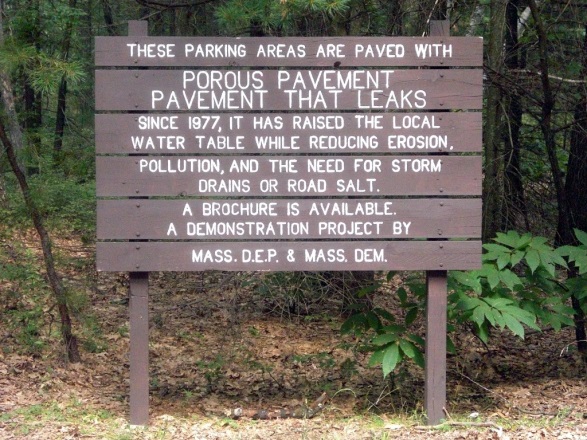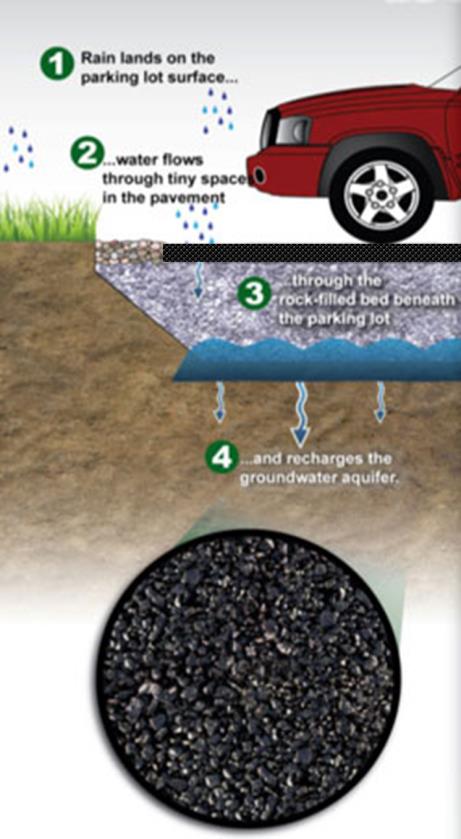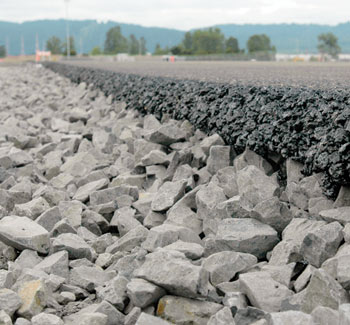 Since the 1960s when the concept of porous pavement was proposed to “promote percolation, reduce storm sewer loads, reduce floods, raise water tables, and replenish aquifers” the concept has been discussed and refined. The concept and application were so appealing that in 1977 the Walden Pond State Reservation in Massachusetts used the material for the parking lot of their visitor center. Since that time it has raised the local water table while reducing erosion, pollution, and the need for storm drains or road salt. They continue to use porous asphalt today to protect a site that serves as one of our most treasured literary muses—Walden Pond.
Since the 1960s when the concept of porous pavement was proposed to “promote percolation, reduce storm sewer loads, reduce floods, raise water tables, and replenish aquifers” the concept has been discussed and refined. The concept and application were so appealing that in 1977 the Walden Pond State Reservation in Massachusetts used the material for the parking lot of their visitor center. Since that time it has raised the local water table while reducing erosion, pollution, and the need for storm drains or road salt. They continue to use porous asphalt today to protect a site that serves as one of our most treasured literary muses—Walden Pond.
Porous asphalt pavements are being used successfully throughout the United States, in every type of climate and geography. They are recognized by the Environmental Protection Agency as a best practice for stormwater management, but we like them because few pavements are giving back more to the planet, making porous asphalt road royalty.
Porous Asphalt Pavement for Stormwater Management
Traditionally pavements are designed to allow rainfall and runoff to flow along the pavement surface, draining into adjacent catch basins and/or ditches of roads or parking lots. Porous asphalt pavement, on the other hand, is a type of type porous pavement structure specifically designed to allow rainfall and runoff to flow into and through the pavement structure. Porous pavement offers the potential to collect and/or slow the rate of run-off from other impervious surfaces. According to the Environmental Protection Agency (EPA) the potential benefits to stormwater management of porous pavements include water treatment/ pollutant removal, reduced or elimination of the need for curbing and storm sewers, and recharge local aquifers.
Porous Asphalt Pavement Structure
The typical porous asphalt pavement structures consist of three components constructed on a permeable subgrade:
The surface course typically consists of a 50-100 mm (2-4 inches) of a specially designed porous or open-graded asphalt mix. This mix is often referred to as an Open Graded Friction Course (OGFC) and has other applications on conventional asphalt pavements. The filter course ranges between 50-75 mm (2-3 inches) consisting of open graded crushed aggregate (either treated with asphalt or untreated) that provides filtering capabilities as well as a providing a suitable platform for paving. The reservoir course is comprised of 50 – 75 mm (2-3 inches) single sized aggregates at a depth determined by the storage volume required. Reservoir depths typically range from 10”-36” in depth.
In comparison to a traditional dense-graded pavement, porous pavement is typically installed as an urban “Best Management Practices” (BMPs) within government agencies for an alternative practice to stormwater management and run-off control.
Porous Asphalt is not Just for Parking Lots
Today, porous pavements are just a small fraction of all pavement installations. However, their popularity is steadily increasing on a percentage basis, and they have been installed in all regions of the United States. Pringle Creek in Salem, Oregon was conceived as a low-environmental-impact community, from its building designs, landscaping and energy systems, to its stormwater control scheme, which relies on roads and parking lots made of porous asphalt pavement to filter and store stormwater and allow it to percolate back into the ground rather than add to the loads on drainage systems that flow into creeks and rivers.
 The system worked well from the beginning, but no one knew for sure how it would perform in severe conditions. So it was a true “watershed” moment in time when an epic storm flooded roads and rivers all over the Salem area in January of 2012, while Pringle Creek experienced nothing more than a puddle or two.
The system worked well from the beginning, but no one knew for sure how it would perform in severe conditions. So it was a true “watershed” moment in time when an epic storm flooded roads and rivers all over the Salem area in January of 2012, while Pringle Creek experienced nothing more than a puddle or two.
The community’s green stormwater system had not only protected the environment, it had saved residents from potentially millions of dollars of storm damage.
Around the country, porous asphalt pavements are the choice for many private companies to satisfy zoning requirements without sacrificing parking space. Porous asphalt pavements are also popular with environmentally sensitive institutions, including Lock Haven University in Pennsylvania, which completed a two-year porous asphalt parking lot project in 2012. Another notable application is the Buffalo, New York street projects where seven residential streets will be converted to porous asphalt pavement to relieve flooding in North Buffalo.
Porous Asphalt has other Applications
Porous asphalt surface mixes are also used by highway engineers but instead of putting it over a stone recharge bed, they use it as a thin surface layer on conventional highway pavements. Rainwater sinks directly into the surface and then hits the impermeable asphalt layer below forcing the water to drain off to the sides. Even in a driving rainstorm, splash and spray from trucks disappear. Visibility for drivers is so much better than crashes and fatalities can be greatly reduced. Although they are thin, these porous asphalt surfacings also improve water quality.
by highway engineers but instead of putting it over a stone recharge bed, they use it as a thin surface layer on conventional highway pavements. Rainwater sinks directly into the surface and then hits the impermeable asphalt layer below forcing the water to drain off to the sides. Even in a driving rainstorm, splash and spray from trucks disappear. Visibility for drivers is so much better than crashes and fatalities can be greatly reduced. Although they are thin, these porous asphalt surfacings also improve water quality.
There are both environmental and safety benefits of porous asphalt pavements including improved stormwater management, improved skid resistance, reduction of spray to drivers and pedestrians, as well as a potential for noise reduction.

